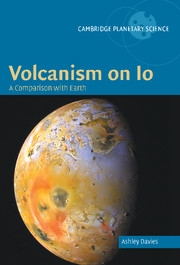Book contents
- Frontmatter
- Contents
- Preface
- List of Abbreviations
- Reproduction Permissions
- Introduction
- Section 1 Io, 1610 to 1995: Galileo to Galileo
- Section 2 Planetary volcanism: evolution and composition
- 4 Io and Earth: formation, evolution, and interior structure
- 5 Magmas and volatiles
- Section 3 Observing and modeling volcanic activity
- Section 4 Galileo at Io: the volcanic bestiary
- Section 5 Volcanism on Io: the global view
- Section 6 Io after Galileo
- Appendix 1 Io hot-spot locations
- Appendix 2 Io maps
- References
- Index
- Plate Section
4 - Io and Earth: formation, evolution, and interior structure
Published online by Cambridge University Press: 05 October 2014
- Frontmatter
- Contents
- Preface
- List of Abbreviations
- Reproduction Permissions
- Introduction
- Section 1 Io, 1610 to 1995: Galileo to Galileo
- Section 2 Planetary volcanism: evolution and composition
- 4 Io and Earth: formation, evolution, and interior structure
- 5 Magmas and volatiles
- Section 3 Observing and modeling volcanic activity
- Section 4 Galileo at Io: the volcanic bestiary
- Section 5 Volcanism on Io: the global view
- Section 6 Io after Galileo
- Appendix 1 Io hot-spot locations
- Appendix 2 Io maps
- References
- Index
- Plate Section
Summary
Volcanism has shaped the surface of the terrestrial planets. Earth, the Moon, Venus, and Mars have all been heavily modified by volcanism during at least some part of their history. Active high-temperature volcanism, with magma at temperatures in excess of 1000 K issuing onto the surface, however, has been observed on only two planetary bodies – Earth and Io (compared in Table 4.1). This high-temperature volcanism is clear evidence of the triumph of interior heating processes over planetary heat loss mechanisms. Interior heating has melted at least part of the planetary mantle to form silicate magmas. The forces primarily responsible for heating within these two bodies, however, are very different.
Why, then, are Earth and Io currently volcanically active? What are the origins of the heat that is generating and being lost through volcanism, and why is Io unique in the jovian system in having high-temperature volcanism? How have these bodies evolved over time?
Global heat flow
First and foremost, it is necessary to quantify surface heat flow in order to model heating and heat transport mechanisms. Determination of heat flow from remote-sensing data is complex, being dependent on the thermal properties of surface and subsurface materials. In Io's case, these properties and materials are not known with any certainty. In comparison, measurement of heat flow on Earth is easily accomplished with in situ measurements.
- Type
- Chapter
- Information
- Volcanism on IoA Comparison with Earth, pp. 53 - 72Publisher: Cambridge University PressPrint publication year: 2007
- 2
- Cited by

